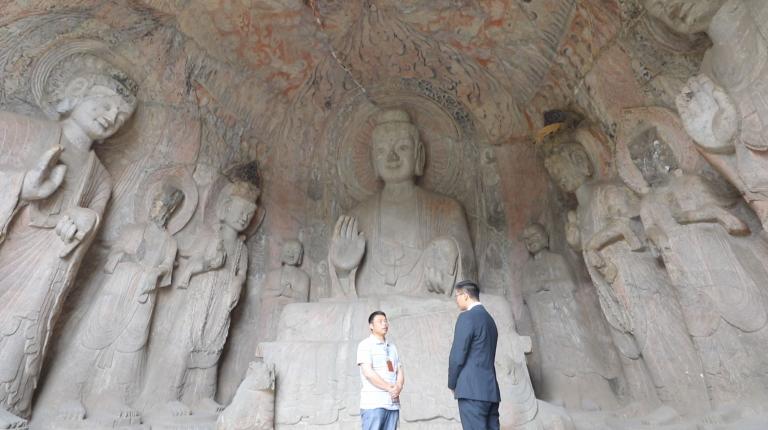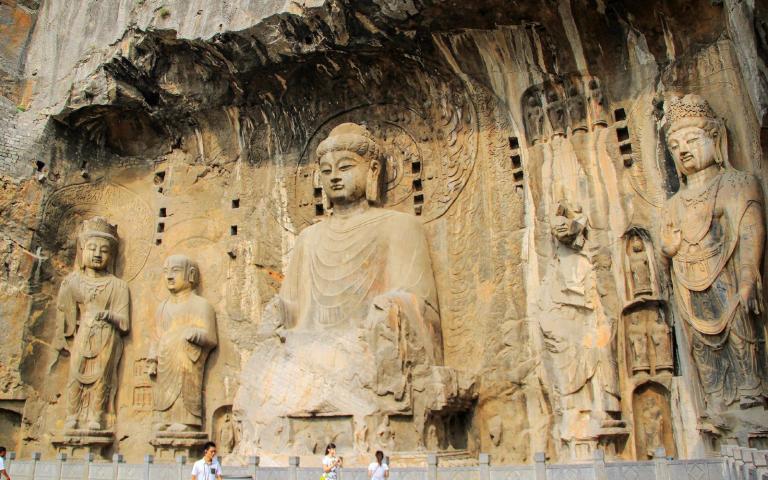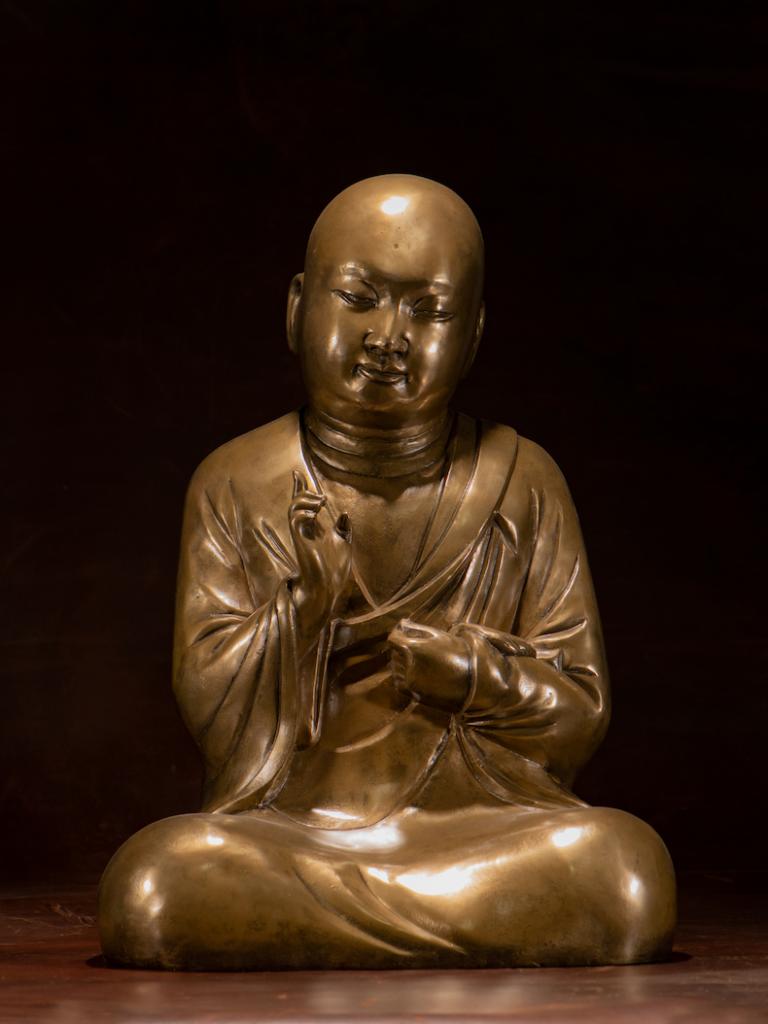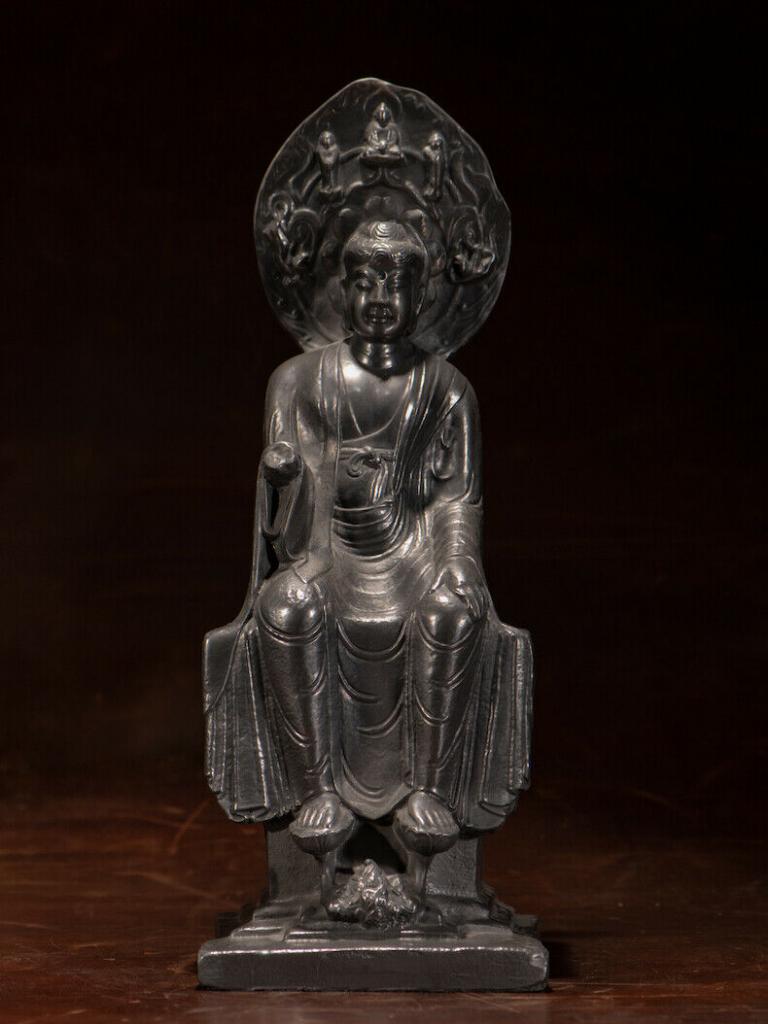Localization of Buddhist Statues in China
12 min readBuddhism began to spread to China in the Eastern Han Dynasty. Liang Sicheng wrote in A History of Chinese Sculpture:”Emperor Huandi believed in Buddhism. In the 8th year of the Yanxi Period(165), he had cast Laozi and Buddha statues, place a canopied chair and play music for offering sacrifices to heaven in the palace, and personally offered sacrifices in the Zhuolong Hall. This was the earliest Buddha statue in China.”Interestingly, the earliest Buddhist statues in China were not Sinicized. After Buddhism spread to China, Buddhist statues were basically images of Greeks with Roman noses, hollow eyes, curled hair and raised moustaches spread from India. In the Northern Wei Dynasty, Buddhist statues gradually possessed Chinese people’s features. With the evolution of the times, more and more importance was attached to Buddhist statues’ manifestation of real Chinese figures’ personalities and moods. After the Taihe Reform by Emperor Xiaowen in the Northern Wei Dynasty, Buddha statues basically had Chinese people’s facial features. The Buddhist art spread from India after being absorbed, integrated and recreated by Chinese artists and artisans finally evolved into Buddhist art with Chinese characteristics. The course of secularization of Chinese Buddhist statues was also a course in which Buddhist culture integrated with Chinese culture and ultimately became a part of Chinese culture.

Dunhuang was a place of strategic importance on the Silk Road in ancient times,and was a transportation hub linking the East and West in the Northern and Southern Dynasties,the Sui Dynasty,the Tang Dynasty,the Five Dynasties and the Song Dynasty.Trade and cultural exchange were quite frequent.After spreading to China,Buddhism took root and germinated here,and left a lot of grotto culture heritage,in which the Dunhuang Grottos with the Mogao Grottos as the main part are the largest and best-preserved.
A colored sculpture of Offering Bodhisattva in Grotto 384, Mogao Grottos, Dunhuang, Tang Dynasty Dunhuang grotto art is comprehensive art integrating architecture, colored sculpture and mural painting. Among them, colored sculpture occupies an importantplace in Chinese sculptural art. Most Dunhuang colored sculptures are statues of Buddhist figures such as Buddha, Bodhisattvas, Ananda, Mahakasyapa, Arhats, Heavenly Kings, Vajras and Nryanas. These statues, the pictures on the walls and ceilings and the lotus bricks on the ground jointly constitute a Buddhist paradise with a strong religious atmosphere.
Now there are more than 2,400 colored sculptures in the Mogao Grottos, the largest one being more than 30 meters tall and the smallest one being only 0.1 meters tall. They gradually evolved from sturdy shapes in the early Northern Wei Dynasty tothin shapes in the late period. After the Sui and Tang dynasties,a group of seven to nine colored sculptures emerged, and the artistic style also became more and more elegant and graceful. Particularly, many excellent works created after the Tang Dynasty such as beautiful and gentle Bodhisattvas and sturdy and valiant Nryanas fully show artists’ excellent skills and their true feelings embodied in them. For example, Grotto 96 among the Mogao Grottos was carved in the early Tang Dynasty.

The large Buddhist statue in the grotto is 35.5 meters tall, and the two knees are 12 meters from each other. It is the largest Buddhist statue in the Mogao Grottos.
According to documents and records, this large Buddhist statue is a statue of Maitreya, the future Buddha among the Buddhas of the Three Ages, built by Buddhist monk Lingyin and lay Buddhist Yinzu in the 1st year of the Wuzhou Zhengsheng Period of the Tang Dynasty(695). The large Buddhist statue’s imposing air is soul-stirring. For another example, the 16-meter-long reclining Buddha statue in Grotto 158 built in the mid-Tang Dynasty manifests Buddha’s state of transcending life and death with graceful curves. The wrinkles on the cassock are curves with a strong sense of rhythm, reflecting gentleness in details and manifesting masculinity overall. This huge reclining Buddha statue harmoniously combines masculinity and femininity as well as force and grace. This is not only the charm of Dunhuang colored sculpture, but also a basic feature of Chinese sculpture. For another example, in Grotto 45, there is a complete group of seven colored sculptures with Buddha at the center. Buddhists, Bodhisattva and the Heavenly King are on both sides. Ananda in a red cassock with both hands in front of the belly looks calm and humble but has youthful spirit; Mahakasyapahas the air of a venerable elder, experienced and prudent with merciful eyes; Bodhisattva is gorgeously dressed, moving elegantly with a graceful facial expression; the Heavenly King wearing armor looks very majestic with one hand akimbo and one hand holding a weapon. In that period, artists shaped the images of Bodhisattva and the Heavenly King according to the images of women and generals inreal life, so these statues seem to have a strong affinity. This group of sculptures shows that the course of secularization of Buddhist statues had been basically completed. This artistic atmosphere vividly showed the Buddhist paradise to people, and was very conducive to the spread of Buddhism in China.
In comparison with the dazzling colored sculptures in the Mogao Grottos, the Buddhist statues in the Yungang Grottos in Shanxi are more magnificent. Particularly, the large 17-meter-tall Buddhist statue in Grotto 20 seems to tower into the sky with overwhelming momentum. Due to earthquakes, the cliff in front of the large Buddhist statue had collapsed, and thus the large Buddhist statue is completely revealed. The statue looks less mysterious than those in grottos but more strapping in sunlight. This large Buddhist statue is a representative work typical of the Northern Wei style withmultifaceted artistic and cultural connotations. It has the dignity of Buddha “revered and respected exclusively in heaven and on earth”, looking down at all living things and in charge of incarnation in the world; also having the Buddhist compassion to “deliver all living creatures from torment”and help people in the world avoid disasters with his infinite supernatural power. In terms of sculptural methods, the large Buddhist statue in Yungang obviously has the Gandhara style combining Indian and Greek characteristics. For example, the face similar to Indians’ contour, the wide area between the eyebrows and the rising nose bridge have Greeks’ features, and the two drooping ears, the broad shoulders and the translucent clothes are all direct results of the Gandhara style’s influence. Meanwhile, the large Buddhist statue’s sturdy shape manifests the physical features of the nomadic ethnic group of Xianbei, and shares the same origin as majestic sculptures of the Qin and Han Dynasties. In short, the large Buddhist statue in Yungang is an outstanding Buddhist statue integrating the sculptural art styles of all times and all countries.

Speaking of large Buddhist statues, the Dazu rock carvings must be mentioned.The Dazu rock carvings, referring to the grotto art mainly manifested as cliff statues in Dazu, Sichuan, include 75 cliff statues, more than 50,000 statues and inscriptions with a total length of more than 100,000 Chinese characters. Among the Dazu rock carvings, the cliff statues on the North Hill and the Baoding Hill are most outstanding, not only numerous and diversified in form, but also representing superb artistic achievements. The cliff statue on the North Hill was built at the foot of a rock with numerous niches and grottos like a beehive. It is reputed as the “museum of grottoart”between the gth century and the 13th century. The large Buddhist statue on theBaoding Hill is 500 meters long with an imposing air, majestic appearance and well-arranged layout, reflecting the complete doctrine system. It is a rare large site for rites of Esoteric Buddhism built according to an overall plan in the world. Each statue not only pursues formal beauty, but also gives emphasis to accurate expression of connotations, making people understand the reasons and touching them emotionally.
The Dazu rock carvings emerged in the late Tang Dynasty and peaked in the SongDynasty, representing Chinese grotto art in the late period. They made important contributions to China’s grotto art innovation and development. The Dazu rock carvings with particular emphasis on sculptural art’s own aesthetic features and formal rules contributed to the transition from grotto statues to cliff statues to a large extent. In terms of shaping techniques, the method of complementation between realistic depiction and exaggeration was used for the statues to create shapes difficult to imitate, express feelings difficult to describe, emphasize contrast between good and evil and between beauty and ugliness, and express contents close to life with both strong artistic charm and great educational effect. In terms of theme selection, they originated from classics but do not rigidly adhere to classics with a high degree of tolerance and creativity. In terms of expression, they break with old forms of traditional religious sculpture, humanize gods and unite gods and people. To sumup, the Dazu rock carvings originated new forms of grotto art in numerous aspects, and became a typical example of grotto art manifesting Chinese traditional culture’s connotations and aesthetic sentiments. Meanwhile, they also represent a turning point in the development of Chinese grotto art. Many new elements of these carvings different from old ones greatly influenced later generations.
Dazu rock carving:a statue of Samantabhadra, Southern Song Dynasty The Dazu rock carvings are a typical example of secularization of religious art, representing an attempt to closely integrate secular life and aesthetic sentiments in terms of contents and expression modes. Among the statues, Buddha, Bodhisattvas, Arhats, Vajras, etc. all seem like pictures of various kinds of people in the society of that period. Particularly, the marvelous cliff statue on the Baoding Hill reflecting a wide range of social life scenes can be called a folk genre painting gallery of the Song Dynasty. After a long period of development, grotto art from India was basically Sinicized. The best example showing this is the Samantabhadra statue in Grotto 136 on the North Hill in Dazu.
Samantabhadra is one of the four famous Bodhisattvas. This statue 2.15 meters tall was carved during the Shaoxing Period of the Southern Song Dynasty(1131-1162).
Samantabhadra sits on a lotus throne sideways, and there is a white elephant under the lotus throne. Samantabhadra is slightly leaning forward and lowering his head with a smile hovering on his lips and a mild and merciful expression. His eyes also are looking down slightly to meet the eyes of men and women worshipping him piously. His left hand is on his leg, and his right hand is holding an S-shaped ornamental object. The patterns of the tassels and corolla are spaced appropriately. Beside the white elephant is an elephant tamer wearing a hero’s scarf and round-neck shirt with tight sleeves, straightening the eyebrows and raising the eyes, and holding the rope tight with both hands in a bold and unrestrained style. The force and outgoingness of the elephant tamer and the grace and constraint of Samantabhadra form a sharp contrast.
Belief in gods instead of religions and belief diversification are a basic feature ofChinese folk religious belief, which is proved by the Dazu rock carvings with material objects. On the one hand, Confucianism, Taoism and Buddhism as three main components of Chinese traditional culture kept integrating in the long course of development. One of the manifestations was that grotto art originally belonging to Buddhism was borrowed by Taoism and Confucianism, and sometimes the founders of the “three religions”appear in the same grotto on the same footing. Among the Dazu rock carvings, there are separate Confucian, Taoist and Buddhist statues, statues integrating Buddhism and Taoism, and statues integrating the “three religions”. These statues show that between the 1oth century and the 13th century, the thought of convergence of the “three religions”for”punishing evildoers, helping kindhearted people and combining the three religions”became a social trend of thought. Secular believer no longer gave attention to the religious boundaries and distinctions amongthe “three religions”. On the other hand, the diverse themes of the Dazu rock carvings also show the Buddhist gods that originated in India and China’s early system of Taoist immortals had integrated with the folk gods that Chinese people believed in in this period, manifesting the trend of belief diversification.
A statue of Avalokitesvara, the Shuanglin Temple, Pingyao, Shanxi, Ming Dynasty If the Dunhuang grottos show the path of localization of Buddhist statues in China, the large Buddhist statue in Yungang built in the Northern Wei Dynasty has an exotic style and the “diverse”Dazu rock carving are still in transition, then the group of sculptures at the Shuanglin Temple reshaped in the Ming and Qing dynasties are completely Sinicized and secularized.
The Shuanglin Temple, originally called the Zhongdu Temple, is located in Pingyao, Shanxi. The year of its establishment can hardly be ascertained. According to the existing tablet inscription in the temple, it was rebuilt in the 21d year of the Wuping Period of the Northern Qi Dynasty (571). In the Song Dynasty, it was renamed the Shuanglin Temple to commemorate Sakyamuni’s entry into nirvana between two Sala trees. The buildings in the Shuanglin Temple with a long history have undergonenumerous natural and man-made calamities, so they were rebuilt or repaired on a large scale in the Ming and Qing dynasties. The existing ones were all built in the Ming and Qing dynasties.
The buildings in the temple are primitive and dignified. Many halls in the three courtyards are full of colored clay figure sculptures. There are a total of 2,052 statues, including 1,566 intact ones. Larger ones are one zhang high, and smaller ones are only one chi long. Thousands of diverse colored sculptures were created with highly realistic methods. The artistic style unifies form and spirit, carrying forward the excellent colored sculpture traditions of the Tang, Song, Liao, Jin and Yuan dynasties.
Inside the gate of the Shuanglin Temple, the first hall is the Hall of the Heavenly Kings. Under the eaves of a veranda are the sculptures of the Four Heavenly Kings about three meters tall arranged in one line. These Buddha’s guards differ from their original shapes and forms, and their sizes, arrangement and images are all different from other temples built in the same period, showing the sculptors’ unique creativity Many Ming statues of the Four Heavenly Kings only highlight the bizarreness and ferocity of the images, but the statues of the Four Heavenly Kings absorb the features of warrior statues and are very realistic, making people feel they have both the affinity of human warriors and the valiant air of Xiang Yu “with strength to lift mountains and spirit to take on the world”.
The hall after the Hall of the Heavenly Kings is the Hall of Sakyamuni, in which Sakyamuni sits high in the middle with Manjusri and Samantabhadra on the left and right. The round sculptures and relief sculptures on the four walls describe the deeds of the founder of Buddhism Sakyamuni from his birth to his entry into nirvana and Buddhahood and his spreading of scriptures for delivering all living creatures from torment in the forms of combined layers and serial wall sculptures. More than 200 figure statues have different identities and facial expressions.
In the second courtyard on the central axis are the Hall of Mahavira, and the Thousand-Buddha Hall and the Bodhisattva Hall on the east and west. In the Thousand-Buddha Hall, there are more than 500 colored sculptures, accounting for one fourth of all colored sculptures in the temple. The main statue in the Thousand-Buddha Hall is a statue of Avalokitesvara at ease. There are a lot of Avalokitesvara statues in the Shuanglin Temple such as the Avalokitesvara crossing the sea and thousand-hand Avalokitesvara. These statues are not like previous solemnly sitting Buddhist statues. The most prominent one is this statue of Avalokitesvara at ease. Different from the image of Avalokitesvara standing in temples, her right leg is lifted high, her right arm is on the knee, her face looks quiet and charming, and her posture is natural. Sitting Avalokitesvara statues are rare in China’s architecture history, and there is no other statue of Avalokitesvara as leisurely and easy as this one.
A standing statue of Skanda, the Shuanglin Temple, Pingyao, Shanxi, Ming Dynasty On both sides of the statue of Avalokitesvara at ease are a Skanda statue and a standing Yaksa statue. The Skanda statue can be called the most brilliant colored sculpture in the Shuanglin Temple with prominent characteristics. Skanda is an important guardian in Buddhism. This Skanda statue looks valiant and dynamic but civilized. His personality is depicted in depth, the exaggeratedly distorted body is full of strength, the facial expression is vivid, and the eyes are especially sharp and lifelike.
The Skanda statue shows movement through stillness. This is the so-called”movement of stillness”in Chinese traditional sculpture and an important reason for its artistic success.
The numerous colored sculptures in the Shuanglin Temple are dazzling, and some walls are even densely covered with hundreds of figure sculptures carved with greatcare. The still clothes, hats and colored ribbons are dynamic. To sum up, the Shuanglin Temple is a treasure of Ming colored sculptures. From the perspective of sculptural art, its importance cannot be ignored.









